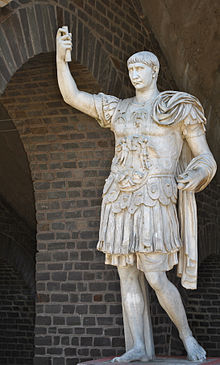Alimenta

The alimenta was a Roman welfare program that existed from around 98 AD to 272 AD. It was probably introduced by Nerva and was later expanded by Trajan. It was designed to subsidise orphans and poor children throughout Italy, but nowhere else, with a cash income, food and subsidized education. The program was an Imperial gift, supported during Trajan's reign by booty from his Dacian wars and estate taxes on landowners.[1] Landowners who registered to contribute received a lump sum from the imperial treasury as a loan, and were expected to repay a given proportion annually, as their contribution to a charitable fund.[2] The program was likely terminated by emperor Aurelian.[3]
Goals
Although the system is well documented in literary sources and contemporary epigraphy, its precise aims are disputed by modern scholars. Some assume that the program was intended to bolster citizen numbers in Italy, a continuation of Augustus' moral legislation (Lex Julia), which favoured procreation on moral grounds. This was openly acknowledged by Pliny.[4] He wrote that the recipients of the alimenta were supposed to populate "the barracks and the tribes" as future soldiers and electors. In reality, both these roles were ill-fitted to an empire ruled as an autocracy,[5] no longer centered exclusively on Rome or Italy, nor exclusively reliant on purely Roman or Italian civil and military manpower.[6] The scheme's restriction to Italy suggests that it might have been conceived as a form of political privilege accorded to the original heartland of the empire.[7] According to the French historian Paul Petit, the alimenta should be seen as part of a set of measures aimed towards the economic recovery of Italy.[8] Finley thinks that the scheme's chief aim was the artificial bolstering of the political weight of Italy, as seen, for example, in the stricture — heartily praised by Pliny — laid down by Trajan that ordered all senators, even when from the provinces, to have at least a third of their landed estates in Italian territory, as it was "unseemly [...] that [they] should treat Rome and Italy not as their native land, but as a mere inn or lodging house".[9]
Scope
"Interesting and unique" as Finley finds the scheme, it remained small.
In short, the scheme was so limited in scope that it could not have fulfilled a coherent economic or demographic purpose — it was directed, not towards the poor, but to the community (in this case, the Italian cities) as a whole.[18] The fact that the alimenta were expanded during and after the Dacian Wars and twice came on the heels of a distribution of money to the population of Rome (congiaria) following Dacian triumphs, points towards a purely charitable motive.[19] The fact that the alimenta were restricted to Italy highlights the ideology behind it: to reaffirm the notion of the Roman Empire as an Italian overlordship.[6] Given its limited scope, the plan was, nevertheless, very successful in that it lasted for a century and a half.
End
Roman prefect
References
- ^ "Alimenta". Tjbuggey.ancients.info. Archived from the original on February 10, 2014. Retrieved April 25, 2014.
- ISBN 0-203-41870-0, page 158
- ^ Southern, Pat, The Roman Empire from Severus to Constantine (2004), pg. 123.
- ISBN 978-0-19-978154-6p. 344
- ^ Veyne 1976, p. 769.
- ^ a b Veyne 1976, p. 654.
- ISBN 978-84-9772-985-7, page 151
- ^ Petit 1976, p. 76.
- ^ Finley 1999, p. 119.
- ^ Finley 1999, p. 40.
- ISBN 0-521-24970-8
- ISBN 978-90-04-17118-3
- ISBN 88-8265-111-8, page 297
- ^ Finley 1999, p. 201–203.
- ISBN 0-19-513912-7
- ISBN 0-521-24970-8
- ^ Finley 1999, p. 203.
- ^ Finley 1999, p. 39.
- ISBN 0-415-23578-2, page 26
- ISBN 978-0-415-73807-1, page 181
Sources and Further Reading
- Elkins, Nathan T. (2017). The Image of Political Power in the Reign of Nerva, AD 96-98. Oxford: Oxford University Press. ISBN 978-0-19-064803-9.
- ISBN 978-0-520-21946-5.
- Grainger, John D. (2003). Nerva and the Roman Succession Crisis of 96-99 AD. London: Routledge. ISBN 978-0-415-34958-1.
- Petit, Paul (1976). Pax Romana. Berkeley: University of California Press. ISBN 978-0-520-02171-6.
- Southern, Pat (2015). The Roman Empire from Severus to Constantine. London: Routledge. ISBN 978-0-415-73807-1.
- Veyne, Paul (1976). Le Pain et le Cirque (in French). Paris: Seuil. ISBN 978-2-02-004507-0.
